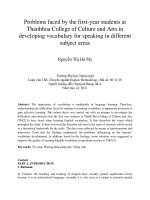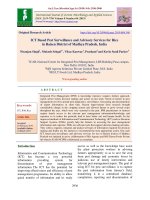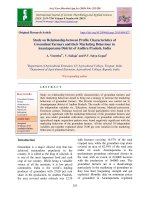Constraints faced by the betel vine growers in Nadia district of west Bengal, India
Bạn đang xem bản rút gọn của tài liệu. Xem và tải ngay bản đầy đủ của tài liệu tại đây (155.11 KB, 6 trang )
Int.J.Curr.Microbiol.App.Sci (2019) 8(4): 80-85
International Journal of Current Microbiology and Applied Sciences
ISSN: 2319-7706 Volume 8 Number 04 (2019)
Journal homepage:
Original Research Article
/>
Constraints Faced by the Betel Vine Growers
in Nadia District of West Bengal, India
Manaranjan Biswas1, Anindita Saha1 and Samir Ranjan Dash2*
1
Department of Agricultural Extension, Palli Siksha Bhavana (Institute of Agriculture),
Visva -Bharati, Sriniketan- 73123, India
2
KVK, Malkangiri, Odisha OUAT, Bhubaneswar-751003, India
*Corresponding author
ABSTRACT
Keywords
Knowledge
Information
System, Transfer of
knowledge,
Employment,
Constraints
Article Info
Accepted:
04 March 2019
Available Online:
10 April 2019
Betel vine (Piper betle L. ) in India is grown as an important cash crop across the states, of
Andhra Pradesh, Karnataka, Kerala, and Tamil Nadu, Assam, Bihar, Madhya Pradesh,
Maharashtra, Odisha, Tripura, Uttar Pradesh and West Bengal. The Indian betel leaves are
in great demand in several countries like where demand far exceeds the local supply.
Cultivation of betel vine is one of the most important horticultural crops, is gradually
increasing its popularity in the Nadia districts as cash crop. A study was undertaken in
Nadia district of West Bengal for analysis of constraints faced by the farmers in betelvine
cultivation covering four blocks Karimpur 1, Karimpur 2, Krishnagang and Chakdaha
taking eight villages selected purposively where the crop is grown as a major crop. A total
200 betel vine growers were selected randomly from eight villages. It is observed that
investment on betel vine cultivation is profitable and attractive in these areas but due to
inadequate information regarding Betel vine production, almost cent per cent growers were
using their own traditional planting material since long and growing their crops with their
indigenous knowledge, skill and their past experiences. They have little knowledge
regarding the improved method of cultivation. The study further indicated that the second
most important constraint found was high cost of Boroj construction followed by lack of
adoption of plant protection measures by the farmers. Based on the study following
recommendations are made for enhancing the profitably of betel vine cultivation in the
study area that the farmers should have easy access to information in related to production
management and marketing aspects.
grown as an cash crop across the states, of
Andhra Pradesh, Karnataka, Kerala, and
Tamil Nadu, Assam, Bihar, Madhya Pradesh,
Maharashtra, Odisha, Tripura, Uttar Pradesh
and West Bengal. India is the largest producer
of betel leaves in the world. The Indian betel
leaves are in great demand in several
countries like where demand far exceeds the
Introduction
Betelvine or Pan (Piper betel L) belongs to
the family Piperaceae and is a perennial
aromatic creeper grown for its leaves. It is an
important commercial crop in India,
Bangladesh and Srilanka and also most
profitable amongst all cultivated crops and is
80
Int.J.Curr.Microbiol.App.Sci (2019) 8(4): 80-85
local supply. Consequently, leaves worth
about Rs. 30-40 million are exported to
European countries (Guha, 2006). It is an
opportunity for the Indian betel vine growers
as well as seller to earn more profit not only
within the country but also by exporting to
European countries. Further, as far as the
national employment generation is concerned,
about 20 million people derive their
livelihoods directly or indirectly from
production,
processing,
handling,
transportation and marketing of betel leaves
in India (Guha, 2006). It is one of the
important commercial crops grown mostly by
Pakistan, Bangladesh, Indonesia, Malaysia,
Burma and Thailand small and marginal
farmers across the country. On an average
about 66% of such production is contributed
by the state of West Bengal where it is
cultivated on about 20,000 ha encompassing
about 4-5 lakh employing about the same
number (4-5 lakh) of agricultural families
(Guha, 2006). Betelvine cultivation has
brought a paradigm shift in the farm economy
West
Bengal
and
offers
perennial
employment and income to small and
marginal farming community because of its
capital and labour intensive characteristic
(Chandra& Sagar, 2004). Betel vines are to be
grown in closed conservatories, locally called
Baroj (artificial conservatory for betelvine
cultivation) with a view to protect the vines
from desiccation in summer, retains
maximum moisture condition, permits little
light and cold in winter, are generally
rectangular in shape and its normal size is
often 50 to 30 sq. meters. Baroj are generally
small because its maintenance ought to be
easy and their cost of erection is within
manageable limits. Cultivation of betel vine
as one of the most important horticultural
crops and gradually gaining its popularity in
this area as cash crop. Betel vine cultivation
has its own overall and holistic socioeconomic impact on the farming community.
Nadia is characterized with multi-faceted
problems such as low crop productivity due to
inherent problem of soil and hence low
returns. Farmers depend on natural resources
completely and are able to cultivate only a
single crop during the rainy season that is
they are bound to mono-cropping (Mandal
2013). It is the most important cash crop and
its cultivation has already brought a
perceptible and conspicuous change in the
livelihood security of farmers in region and its
farming population. Farmers are selling their
produce at local markets as well as at distant
markets like Karimpur and Shimurali or in
other markets.
However, the betel vine is susceptible to
damage caused by insects, rain and wind.
Shortage of irrigation can also cause
hindrance for the growth of betel vine. High
cost of fertilizer and pesticide, fluctuating
price, many intermediaries, inadequacy of
finance, transport, absence of grading, lack of
storage facility also cause of great loss to
farmers. Chewing is slowly replaced by the
areca product made for chewing, which leads
to decrease in demand for betel leaves. In
view of the above problems in betel vine
cultivation the current study was undertaken
for identifying the constraints in production
and marketing of betel vine in the study area.
The constraints were operationally defined as
the difficulties experienced by the farmers in
adoption of improved production technology.
In the present study efforts have been made to
know the constraints faced by the Betel vine
growers.
Materials and Methods
The present study was undertaken to identify
constraints of Betel vine growers in Nadia
district of west Bengal. Multi-stage stratified
sampling procedure was employed for
selection of blocks, villages and betel vine
growers. This study has been conducted in the
Nadia district of West Bengal covering four
81
Int.J.Curr.Microbiol.App.Sci (2019) 8(4): 80-85
blocks namely Karimpur 1, Karimpur 2,
Krishnaganj, and Chakdah. The blocks were
selected purposively because these blocks are
leading in terms of area and production of
betel vine in the district and also presence of
wholesale market in Karimpur town. A
sample size 200 betetlvine growers were
randomly selected from eight villages
covering four blocks were selected as the
respondents. Although betel vine cultivation
is profitable, but many farmers were
switching over to other crops from betel vine
due to lack of money/credit facilities and also
high price uncertainty in the local market
(Absar, 2015). Considering this, the study was
organised with an objective to study the
constraints faced by farmer according to
ranking. The primary data were collected
from the sample farmers on pre-structured
schedules through personal interview method
for the agricultural year 2015-2016. For
measurement of these variables a list of
various constraints was prepared in
consultation with the farmers, extensionists
and researchers. In order to study the
frequency of constraints, one frequency
continuum was prepared against each
constraint as most often, often, some times
and never, and assigned score were 4, 3, 2, 1
respectively. The total preference score for
each content was calculated and mean sore for
particular constraints was worked out then
ranking was done as the basis of CV
percentage.
order of merit assigned by the respondents
was changed in to ranks by employing the
formulas as, Percent position. The position of
each rank is converted into score by referring
tables given by Garret and Woodworth
(1969). Then for each factor, the score of
individual respondents are added together and
divided by the total number of respondents for
whom scores are added. The mean scores for
all the factors are ranked by arranging in
descending order.
The selected growers were asked to indicate
the constraints through a structured suitable
scheduled. The information collected by
interviewing the selected Betel vine growers
and tabulated them to identify the most
important constraints by ranking them in the
sampled areas. The suitable statistical tools
like percentage, mean, Standard deviation and
CV% were used for analysis and
interpretation of the data. On the basis of the
mean score and Co-efficient of variance rank
order was made. The variables were ranked
according to their consistency, the item then
securing lowest CV% has given first rank and
so on. The collected data were analyzed and
rank was determined and presented in Table1.
From the above table it was inferred that
almost all enlisted constraints had been faced
by the farmers in betel vine cultivation.
However, in-adequate information regarding
betel vine production was the main constraint
expressed by the farmers. It may be observed
from above table that, in adequate information
regarding Betel vine production (13.501%) in
the sampled areas, was the main constraint
expressed by the farmers. Almost cent percent
growers were using their own traditional
planting material since long and growing their
crops with their indigenous knowledge, skill
and their past experiences. They have little
awareness regarding the improved method of
cultivation. The second most constraint
Results and Discussion
Detailed information on betel vines such as
starting year, list of various constraints was
prepared after detail discussion with the
farmers. Then farmers were asked to assign
rank to these constraints during personal
interview. Based on the rank assigned by
farmers, constraints have been prioritized
through computing rank following standard
procedure and with the help of table. The
82
Int.J.Curr.Microbiol.App.Sci (2019) 8(4): 80-85
reported by the farmers was high cost for
construction of Baroj (21.56%) as the Betel
vine crops entirely dependent on construction
of Baroj. The results are in agreement with
the findings of Balasubrahmanyam et al.,
(1990).
Table.1 Constraints faced by the Betel vine growers
Constraints
Frequency continuum
Mean
Std Error
CV %
Ranking
1.085
0.022
28.89
ix
2.025
0.019
13.50
i
Credible source of knowledge & information
2.095
0.038
25.59
vi
Lack of research regarding betel vine
2.790
0.059
29.75
xii
High cost for construction of baroj
3.560
0.054
21.56
ii
Lack of plant protection measure
3.650
0.056
21.58
iii
Lack of Suitable and own land of farmers
2.400
0.075
44.20
xvi
Lack of farmer association/organizations
1.640
0.045
39.16
xv
Inadequate / transport/ storage facilities
2.130
0.056
37.44
xiii
Lack of government financial support/ bank loans
2.620
0.054
29.28
x
Lack of facility provided by Assistant Director of
3.205
0.059
25.85
vii
Low frequency visit by ADA/KPS
3.395
0.054
22.46
iv
In adequate procurement price
1.865
0.072
54.46
xviii
Lack of communication facilities to farmers doorstep
1.580
0.038
33.79
xiii
Negative attitude of extension worker to the farmers
2.250
0.041
25.88
viii
Lack of interest of extension personnel
2.890
0.049
23.98
v
Lack of incentives
3.385
0.069
28.96
xi
In adequate knowledge of Local dealer
2.355
0.095
56.77
xix
Lack of skilled labour
1.795
0.048
37.58
xiv
Lack of storing facility
2.090
0.069
46.55
xvii
High cost of labour
2.325
0.046
28.25
xii
Lack of time
Inadequate
information
regarding
betel
vine
production
Agriculture / Horticulture Development Officer etc
problems
The results given in above Table revealed that
the third most important constraint, reported
by the sampled growers was lack of plant
protection measure (21.58%). Majority of
growers did not know the specific pest and
pesticides. They mainly depend on local
vendors/ sellers which was generally not so
effective for plant protection measure. Most
of the growers in the study area were using
their own traditional planting material since
83
Int.J.Curr.Microbiol.App.Sci (2019) 8(4): 80-85
long and growing their crops with their
indigenous knowledge, skill and their past
experiences. They have little awareness
regarding the improved method of cultivation.
The constraints like low frequency visit by
extension functionaries (22.46%), lack of
interest of extension personnel and credible
source of knowledge & information were
faced by majority of the respondents.
constraints faced by the betel vine growers.
Price fluctuation was the most important
constraints faced by the betel vine cultivators
to realise remunerative return to the
investment on betel vine cultivation.
Unauthorized deductions by the traders,
middleman and (commission agents) non
availability of storage facilities were other
pertinent problems faced by the famers. Based
on the study following recommendations are
made for enhancing the profitably of betel
vine cultivation in the study area that the
farmers should have easy access to
information in related to production
management
and
marketing
aspects.
Establishment of market information system
to forecast the price in a-priori and
simultaneously exploring the export market
might be useful for realising better return
from betel vine cultivation. It is also inferred
that young farmers are quite enthusiastic to
cultivate the betel vine and promotion of this
cash crop should be continued in other parts
of the Nadia districts for employment
generation to enhance farmer’s income from
betel vine cultivation.
The constraints moderately faced by the
respondents lack of interest of extension
personnel(23.981), Credible source of
knowledge and information (25.590), Lack of
facility provided by ADA/HDO/KPS
(25.850), Negative attitude of extension
worker to the farmers problems (25.885),
High cost of labour (28.259), Lack of time
(28.892), Lack of incentives (28.969) Lack of
government support/Bank loan (29.281),
Inadequate
transport/
storage
facility
(37.449), Lack of skilled labour (37.589).The
least important constraints as mentioned by
less number of farmers were, lack of farmer
association/ organization (39.161), Lack of
suitable and own land of farmers (44.207),
Lack of storing facility (46.533) followed by
in- adequate procurement price (54.469). The
similar findings have been reported by
Acharjee (1992).
References
Acharjee, S.K. (1992). Study on the
relationship of some socio cultural and
economic
characteristics
with
modernization of Betel vine Dept. of
Agril. Extension, unpublished Ph. D
Thesis.
BalaSubrahmanyam, M.H, Balchandra, P. and
Mathirajan (2005). Technological
innovations in small scale industries:
case studies of two foundries in
Karnataka. South Asian Journal of
Management, 11(3), 111-120.
Chandra, G. and Sagar, R. L. (2004).
Harvesting green gold: Cultivation of
betelvine in sundarban. Indian
Farmers Digest, 37(3), 5-13.
Garrett, H. E. and Woodworth, R. S. (1969).
In conclusion, the study indicated that inadequate information regarding Betel vine
cultivation management in the sampled areas,
almost sent percent growers using their own
traditional knowledge in their field. They
have little awareness regarding the improved
method of cultivation. Lack of adequate
knowledge is the most important constraint
faced by the betel vine cultivators to enhance
their production. High cost of Baroj
construction, Lack of plant protection
measure, Low frequency of diagnostic field
visit of government officials, natural
calamities, lack of interest of Extension
personnel were the other most important
84
Int.J.Curr.Microbiol.App.Sci (2019) 8(4): 80-85
Statistics
in
Psychology
and
Education, Feffer and Simons Pvt.
Ltd., Vakils, P: 329.
Guha . P. (2004). Development of technology
for enhancing shelf life of Betel
leaves, Annual report of All India
Coordinated Research Project on post
harvest technology (ICAR). IIT,
Kharagpur (Ed), Food and Agriculture
Engineering
Department,
IIT,
Kharagpur, India, pp 39-56.
Guha, P. (2006). Betel Leaf: The Neglected
Green Gold of India. Journal of
Human Ecology, 19 (2): 87-93.
Gupta, J, (1998). A study of the information
management in diary knowledge
information system, Ph.D. thesis.
Kumar, P , Pandey, A. K. And Das, S. (2018).
Epidemiological Factors Affecting
Phytopthora Leaf rot and Anthracnose
leaf Spot Diseases of Betel vine (Piper
betle) and their Control, International
Journal of Current Microbiology and
Applied, Science (7): 4610-4616.
Lahiri, D. (2000). "Marketing of Betel Leaves
in Midnagpur District, West Bengal",
Indian Journal of Agricultural
Marketing, p.112.
Mandal, Subhasis, S.K. Sarangi, D. Burman,
B.K. Bandyopadhyay, B. Maji, U.K.
Mandal and D.K. Sharma (2013).
Land Shaping Models for Enhancing
Agricultural Productivity in Salt
Affected Coastal Areas of West
Bengal –An Economic Analysis, (3):
389-401.
Pal, P.P. (1999). Information seeking
behaviour of tribal farmers of
Meghalaya, Indian Journal of Hill
Farming, 12(1-2): 124-125.
Rao, N. H. (2006). A framework for
implementing
information
and
communication
technologies
in
agricultural development in India.
Technological Forecasting and Social
Change 74(4): 491-518.
Saha, (2001). An Analysis of the Dairy
Knowledge Information System in
Birbhum, West Bengal. MSc. Thesis,
NDRI, Karnal, Haryana.
Van Beek, P.G.H. (1991). The Queensland
Dairy AKIS. Proceedings of European
Seminar on Knowledge Management
and Information Technology, Agril.
University, Wageni.
How to cite this article:
Manaranjan Biswas Anindita Saha and Samir Ranjan Dash. 2019. Constraints Faced by the
Betel Vine Growers in Nadia District of West Bengal, India. Int.J.Curr.Microbiol.App.Sci.
8(04): 80-85. doi: />
85









